The skies are no longer just for birds and aeroplanes. A new era of urban mobility is on the horizon, and it promises to transform how we think about transportation.
Flying taxis, once a concept confined to science fiction, are now becoming a tangible reality. The collaboration between Embraer and Eve leads this aerial revolution, two giants with a vision to redefine urban landscapes.

Their ambitious project, set to take off in Brazil, is a testament to the boundless possibilities of human innovation and the future of sustainable transportation.
Location and Logistics: Why Taubate?
For good reasons, Brazil’s Taubate has been chosen as the epicentre of this groundbreaking venture. Nestled strategically, Taubate offers a blend of logistical advantages, making it an ideal location for the flying taxi factory. Its proximity to Embraer’s headquarters in Sao Jose dos Campos is not just about geographical closeness; it’s about synergizing resources, expertise, and vision.
The city boasts easy access via two major highways and is closely connected to a railroad, ensuring seamless transportation of materials and finished products. Furthermore, the region’s closeness to Eve’s engineering and human resources team will play a pivotal role in fostering innovation, streamlining production processes, and ensuring that the flying taxis are efficient and world-class.
The eVTOL: A Glimpse into the Future
Imagine a vehicle that can take off vertically, hover above traffic jams, and transport you to your destination in a fraction of the time it would take on the ground. This is the promise of the electric vertical take-off and landing aircraft, or eVTOL. Designed with precision and a keen eye for detail, the eVTOL is set to be the crown jewel of Embraer and Eve’s collaboration.
But what sets this aircraft apart? For starters, it has eight rotors that provide vertical lift and two pusher propellers that ensure smooth and efficient flight. The design is not just about aesthetics; it’s about maximizing passenger safety, comfort, and the overall flying experience. With plans to have the eVTOL operational and flying passengers by 2026, the clock is ticking, and the excitement is palpable.
Economic Implications and Market Potential
The venture between Embraer and Eve is backed by an investment of BRL 100 million ($19.5 million) earmarked for the Taubaté facility. This investment is intended not just to build a factory but to position Brazil as a global leader in the urban air mobility sector.

The market potential for flying taxis could be vast. As urban centres grapple with congestion, pollution, and transportation inefficiencies, the eVTOL offers a sustainable and efficient solution. Embraer and Eve have already garnered significant interest from global clients, with orders pouring in. The factory in Taubaté is expected to produce up to 200 aircraft annually, signalling a robust demand and a bright future for the eVTOL.
But the economic implications extend beyond production numbers. The flying taxi industry is poised to create a ripple effect, spurring growth in ancillary sectors, from maintenance and servicing to infrastructure development for take-off and landing zones. As the first eVTOLs take to the skies, they promise to bring a wave of economic prosperity and innovation.
Challenges and the Road Ahead
Every pioneering venture comes with challenges, and the flying taxi industry is no exception. While the vision is clear and the commitment unwavering, Embraer and Eve are gearing up to navigate a series of technical, operational, and certification hurdles.
Safety is paramount. The eVTOL, despite its advanced design, will need to undergo rigorous testing and certification processes to ensure passenger safety. Regulatory bodies will play a crucial role in shaping the future of urban air mobility, and collaboration will be essential.
From integrating eVTOLs into existing air traffic to developing infrastructure for vertical take-offs and landings, operational challenges will need innovative solutions. The road ahead is uncharted, but with the combined expertise of Embraer and Eve, the journey promises to be transformative.
The need for innovative transportation solutions becomes increasingly evident as cities continue to grow and evolve. The collaboration between Embraer and Eve is not just about creating a new mode of transport; it’s about envisioning a future where the skies are an integral part of our daily commute—a lot where flying taxis are as commonplace as cars on the road today.

The eVTOL represents more than just a technological marvel. It embodies hope for a sustainable future, a promise of reduced carbon emissions, and a vision of efficient urban mobility. As the first flying taxis prepare to take off from the Taubaté facility, they carry with them the aspirations of millions who dream of a world where traffic jams are a thing of the past, and the skies are open to all.
TLDR of the Article:
- Embraer and Eve collaborate to pioneer the flying taxi industry with a new facility in Taubaté, Brazil.
- The eVTOL, an electric vertical take-off and landing aircraft, promises efficient and sustainable urban mobility.
- With an investment of BRL 100 million, the project aims to produce up to 200 aircraft annually.
- The venture faces challenges, from safety certifications to operational integration, but holds vast economic potential.
- As the first eVTOLs prepare for take-off, they signal the dawn of a transformative era in urban transportation.





